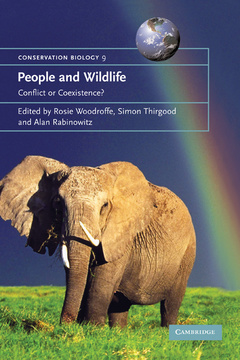People and Wildlife, Conflict or Co-existence? Conservation Biology Series
Langue : Anglais
Coordonnateurs : Woodroffe Rosie, Thirgood Simon, Rabinowitz Alan

This book discusses whether, and how, coexistence of people and endangered wildlife may be encouraged.
Human-wildlife conflict is a major issue in conservation. As people encroach into natural habitats, and as conservation efforts restore wildlife to areas where they may have been absent for generations, contact between people and wild animals is growing. Some species, even the beautiful and endangered, can have serious impacts on human lives and livelihoods. Tigers kill people, elephants destroy crops and African wild dogs devastate sheep herds left unattended. Historically, people have responded to these threats by killing wildlife wherever possible, and this has led to the endangerment of many species that are difficult neighbours. The urgent need to conserve such species, however, demands coexistence of people and endangered wildlife. This book presents a variety of solutions to human-wildlife conflicts, including novel and traditional farming practices, offsetting the costs of wildlife damage through hunting and tourism, and the development of local and national policies.
Foreword John G. Robinson; 1. The impact of human-wildlife conflict on natural systems Rosie Woodroffe, Simon Thirgood and Alan Rabinowitz; 2. The impact of human-wildlife conflict on human lives and livelihoods Simon Thirgood, Rosie Woodroffe and Alan Rabinowitz; 3. Characterisation and prevention of attacks on humans Howard Quigley and Stephen Herrero; 4. Non-lethal techniques for reducing depredation Urs Breitenmoser, Christof Angst, Jean-Marc Landry, Christine Breitenmoser-Wursten, John D. C. Linnell and Jean-Marc Weber; 5. Techniques to reduce crop loss: human and technical dimensions in Africa F. V. Osborn and C. M. Hill; 6. Evaluating lethal control in the management of human-wildlife conflict Adrian Treves and Lisa Naughton-Treves; 7. Bearing the cost of human-wildlife conflict: the challenges of compensation schemes Philip J. Nyhus, Steven A. Osofsky, Paul Ferraro, Francine Madden and Hank Fischer; 8. Increasing the value of wildlife through non-consumptive use? Deconstructing the myths of ecotourism and community-based tourism in the tropics M. J. Walpole and C. R. Thouless; 9. Does extractive use provide opportunities to offset conflicts between people and wildlife? N. Leader-Williams and J. M. Hutton; 10. Zoning as a means of mitigating conflicts with large carnivores: principles and reality John D. C. Linnell, Erlend Birkeland Nilsen, Unni Stobet Lande, Ivar Herfindal, John Odden, Ketil Skogen, Reidar Andersen and Urs Breitenmoser; 11. From conflict to coexistence: a case study of geese and agriculture in Scotland David Cope, Juliet Vickery and Marcus Rowcliffe; 12. Hen harriers and red grouse: the ecology of a conflict Simon Thirgood and Steve Redpath; 13. Understanding and resolving the black-tailed prairie dog conservation challenge Richard P. Reading, Lauren McCain, Tim W. Clark and Brian J. Miller; 14. People and elephants in Shimba Hills, Kenya Timothy J. Knickerbocker and John Waithaka; 15. Safari hunting and conservation on communal land in southern Africa Dale Lewis and John Jackson; 16. Socioecological factors shaping local support for wildlife: crop raiding by elephants and other wildlife in Africa Lisa Naughton-Treves and Adrian Treves; 17. Jaguars and livestock: living with the world's third largest cat Alan Rabinowitz; 18. People and predators in Laikipia District, Kenya Laurence G. Frank, Rosie Woodroffe and Mordecai O. Ogada; 19. Searching for the coexistence recipe: a case study of conflicts between people and tigers in the Russian far east Dale Miquelle, Igor Nikolaev, John Goodrich, Boris Litvinov, Evgeny Smirnov and Evgeny Suvorov; 20. A tale of two countries: large carnivore depredations and compensation schemes in Sweden and Norway Jon E. Swenson and Henrik Andren; 21. Managing wolf-human conflict in the northwestern United States Edward E. Bangs, Joseph A. Fontaine, Michael D. Jimenez, Thomas J. Meier, Elizabeth H. Bradley, Carter C. Niemeyer, Douglas W. Smith, Curt M. Mack, Val Asher and John K. Oakleaf; 22. Policies for reducing human-wildlife conflict: a Kenya case study David Western and John Waithaka; 23. An ecology-based policy framework for human-tiger coexistence in India K. Ullas Karanth and Rajesh Gopal; 24. The future of coexistence: resolving human-wildlife conflicts in a changing world Rosie Woodroffe, Simon Thirgood and Alan Rabinowitz.
Rosie Woodroffe is Assistant Professor of Conservation Biology at the University of California, Davis.
Simon Thirgood is Science Leader of the Ecology of Grazed Ecosystems Programme at the Macaulay Institute in Aberdeen, Scotland.
Alan Rabinowitz is Director of the Science and Exploration Division for the Wildlife Conservation Society based at the Bronx Zoo in New York.
Simon Thirgood is Science Leader of the Ecology of Grazed Ecosystems Programme at the Macaulay Institute in Aberdeen, Scotland.
Alan Rabinowitz is Director of the Science and Exploration Division for the Wildlife Conservation Society based at the Bronx Zoo in New York.
Date de parution : 08-2005
Ouvrage de 516 p.
15.9x23.6 cm
Date de parution : 08-2005
Ouvrage de 516 p.
16.9x22.8 cm
Thème de People and Wildlife, Conflict or Co-existence? :
© 2024 LAVOISIER S.A.S.



